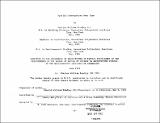Spatial consequences over time
Author(s)
Bradley, Charles William
DownloadFull printable version (5.225Mb)
Other Contributors
Massachusetts Institute of Technology. Dept. of Architecture.
Advisor
Tunney Lee.
Terms of use
Metadata
Show full item recordAbstract
The primary aim of this thesis is to understand contradictions between the actual use by residents and the patterns chosen by the designers. The case chosen is Warren Gardens which is a moderate income housing project located in Roxbury, Mass. The project, built in 1968, revealed over time contradictions or spatial limits. These contradictions or spatial limits, identified through interviews with present users were analyzed and synthesized into a set of design guidelines. These guidelines were tested by design on one unit type using the existing shell. This testing helps support the conjecture that the existing unit dimensions should be either increased or left unchanged in order to: provide more varied patterns for the designers; and meet the user(s) changing attitudes and needs for space over time. This analysis, concentrating on one unit type, tested whether the spatial limits of these layouts constitute unmet spatial needs that could have been detected and incorporated into the design, process. These spatial limits were used to analyze: whether the chosen patterns have satisfied the changing needs for space over time ; if these spatial limits are important to consider; and should the existing layout patterns satisfy the changing spatial needs and attitudes over time. It was concluded that changes over time in family size and relationships and spatial usage turned out to be more important than the initial patterns chosen by the designers.
Description
Thesis (M.S.)--Massachusetts Institute of Technology, Dept. of Architecture, 1983. MICROFICHE COPY AVAILABLE IN ARCHIVES AND ROTCH Includes bibliographical references (p. 91-92).
Date issued
1983Department
Massachusetts Institute of Technology. Department of ArchitecturePublisher
Massachusetts Institute of Technology
Keywords
Architecture.